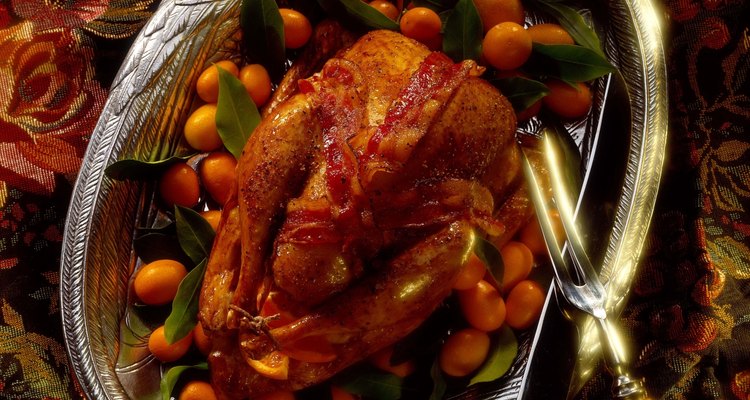
The rise of the gourmet and specialty food industries have made pheasant more widely available in urban markets and to people who do not hunt. It is no longer unusual to see pheasant featured on restaurant menus or available in the retail market, including national grocery store chains. Pheasants, like many game birds, are leaner than the chickens and turkeys that the average person is accustomed to cooking. When cooking or reheating pheasant, extra care must be taken to prevent dryness.
Waste Not, Want Not
The first step to success in reheating pheasant is to handle cooked or leftover pheasant with food safety in mind. Take-out foods that are not going to be eaten right away and leftovers need to be refrigerated within two hours to prevent the growth of bacteria. Leftover food should be eaten within two days. If you don't plan on eating leftovers during that period of time, it is better to wrap them securely, label and store in the freezer.
Cover and Simmer
The method used to reheat pheasant will depend on how it is prepared. Pheasant is often slow cooked with liquid to prevent dryness, such as in a covered slow-cooker or a heavy, covered skillet. When reheating this type of pheasant dish, place it in a heavy saucepan or skillet with the remaining cooking juices, stock, sauce or gravy. If there's not quite enough of the liquid it was cooked in or served with, add some water. Cover, and gently simmer over low heat until the sliquid comes to a boil and food is hot. Watch carefully to make sure that the pan doesn't go dry, adding more liquid as necessary.
Steam to Keep Moist
When reheating pheasant that has been made into a casserole or similar type of dish, steaming can be an excellent option. Using this method helps to protect against dryness while ensuring that the food heats all the way through, as food safety guidelines require. If you don't have a steamer, you can put a colander in a 4-quart or larger pot. Put a few inches of water in to produce the steam. Put a small pie or cake pan in the colander. It should be of a size that it doesn't cover all of the colander holes. If you don't have the right sized pan, use a piece of foil, curving the sides upwards so you don't loose any juices. Cover the pot tightly and cook over medium high heat until hot all the way through, making sure that the pot doesn't run out of water. Timing will depend on the density of the casserole.
Microwave With Care
If you do use the microwave to reheat pheasant, use caution to avoid drying it out and spoiling your meal. If it is a dry dish, meaning one without its own liquid, like a sauce or gravy, sprinkle with some water to produce a bit of steam. Cover with plastic wrap to help retain moisture. Make sure to remove plastic wrap in a manner that ensures the steam will move away from you as it escapes. If necessary, sprinkle with a little water after flipping it on the plate, then return it to the microwave for the second half of the reheating. Heat until hot all the way through. If reheating a dish with a sauce or gravy, it needs to bubble before you take it out.
Related Articles

How to Use a Hob Steamer

The Steps in Cooking Raw Foods in a ...

How to Reheat Lasagna

How to Make Homemade Mac & Cheese

How to Cook a Partridge
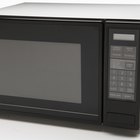
Can You Cook Something Frozen in the ...
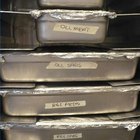
Catering Tips for Delivering Food

How to Cook With a Gas Fireplace
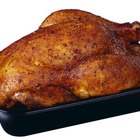
How to Use the Steamer on the Showtime ...

How to Heat Pre-Cooked Hams
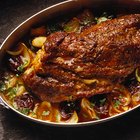
How to Use a Roaster for Pork
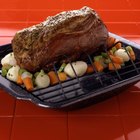
How to Cook a Whole Sirloin Tip Beef ...

How Do I Reheat Leftover Boiled Lobster?
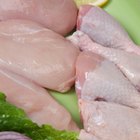
How to Soak Chicken in Cold Water
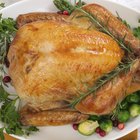
How to Defrost a Turkey
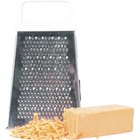
How Can I Cook a Small Batch of Food in ...

How Long Are Tamales Supposed to Cook?
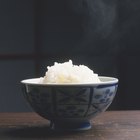
How to Re-Heat Cooked Rice
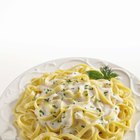
Can You Make Chicken Fettuccine Alfredo ...
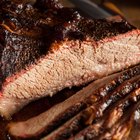
How to Steam a Brisket of Beef
References
Resources
Writer Bio
Sharon Secor began writing professionally in 1999, while attending Empire State University. Secor specializes primarily in personal finance and economics, and writes on a broad range of subjects. She is published in numerous online and print publications, including Freedom's Phoenix, the ObscentiyCrimes and the American Chronicle.
Photo Credits
Jupiterimages/Comstock/Getty Images